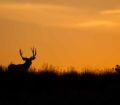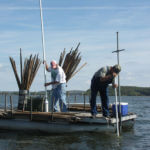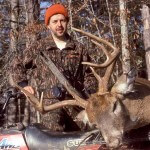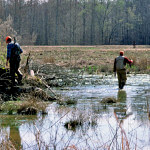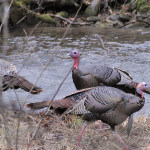 Editor’s Note: Mark Drury of Drury Outdoors (https://www.druryoutdoors.com/) is known first and foremost as an expert white-tailed deer hunter and turkey hunter. You can forecast deer movement with his app at (https://www.druryoutdoors.com/deercast.php#.W9H2GeJOmUk) that combines local weather info with the distinct characteristics of each of the 13 phases of whitetail season to deliver a custom forecast for peak deer activity of where you should hunt down to the hour. This app combines 70 years of Mark and Terry Drury’s whitetail-hunting expertise with hour-by-hour real-time algorithm-driven deer movement forecasts and an abundance of videoed Mossy Oak hunts. But what you may not know is that Mark also enjoys hunting mule deer and uses what he learns during mule deer hunting in September and October every year to prepare for whitetail season.
Editor’s Note: Mark Drury of Drury Outdoors (https://www.druryoutdoors.com/) is known first and foremost as an expert white-tailed deer hunter and turkey hunter. You can forecast deer movement with his app at (https://www.druryoutdoors.com/deercast.php#.W9H2GeJOmUk) that combines local weather info with the distinct characteristics of each of the 13 phases of whitetail season to deliver a custom forecast for peak deer activity of where you should hunt down to the hour. This app combines 70 years of Mark and Terry Drury’s whitetail-hunting expertise with hour-by-hour real-time algorithm-driven deer movement forecasts and an abundance of videoed Mossy Oak hunts. But what you may not know is that Mark also enjoys hunting mule deer and uses what he learns during mule deer hunting in September and October every year to prepare for whitetail season.
I was hunting with friends on the side of a hill when we spotted a mule-deer buck that would score about 165 Pope & Young (https://pope-young.org/). Over the years, I’ve learned that when mule-deer hunting that you must have the wind in your favor to stalk mule deer. So, we went way around the hill when we saw this buck, and we let him walk under us – further down the hill. We were hoping the buck would take a trail that was about 30-yards away from where we were. But instead he took a trail that was about 61-yards directly away from us. I knew I had a very-steep angle to shoot that muley. When I started aiming, the mule deer buck was almost straight below me.
That’s exactly the reason I suggest that anyone planning to hunt mule deer practice shooting with an angle-compensation range finder like my Leupold. The only way you can build confidence in a range finder is to practice with it. I’ve been using this range finder for so long that I’ve learned to trust it. I’ll shoot whatever yardage the range finder tells me to shoot. No matter what kind of terrain and the angle 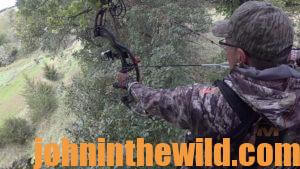 you must shoot when you’re hunting, I’ve learned that my angle-compensation device in my range finder doesn’t lie. Even when the yardage it tells me sometimes doesn’t make any sense, I know to believe in my range finder. Whatever that range finder tells me the yardage to shoot, I’ve learned through the years to trust it implicitly. I know that the range finder I use works perfectly with the IQ bowsight (https://www.feradyne.com/iq-bowsights/) I use. I believe I can make any shot, as long as I trust my range finder and my sight. I’ve always been able to shoot a bow fairly well. The longer distances that I shoot and the different angles I shoot have given me confidence that I can absolutely trust that range finder and bowsight.
you must shoot when you’re hunting, I’ve learned that my angle-compensation device in my range finder doesn’t lie. Even when the yardage it tells me sometimes doesn’t make any sense, I know to believe in my range finder. Whatever that range finder tells me the yardage to shoot, I’ve learned through the years to trust it implicitly. I know that the range finder I use works perfectly with the IQ bowsight (https://www.feradyne.com/iq-bowsights/) I use. I believe I can make any shot, as long as I trust my range finder and my sight. I’ve always been able to shoot a bow fairly well. The longer distances that I shoot and the different angles I shoot have given me confidence that I can absolutely trust that range finder and bowsight.
I don’t shoot out to 100 yards when I’m practicing, because I usually don’t have that much land where I can practice those longer shots. I believe I might could shoot at 100 yards, if I practiced at that distance. I do practice shooting at 70-80 yards most of the time. I 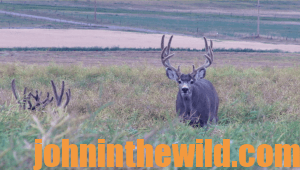 rarely practice at shorter distances, except when I’m checking my pinsights to be sure that they’re on target at those shorter distances. If you can correct the mistakes you make at 60-70 yards with your bow, then you should be able to shoot a nickel-sized target at 20-30 yards. If you can keep your arrows within a softball-sized target at 60-80 yards, you absolutely can dot an i at 20-30 yards.
rarely practice at shorter distances, except when I’m checking my pinsights to be sure that they’re on target at those shorter distances. If you can correct the mistakes you make at 60-70 yards with your bow, then you should be able to shoot a nickel-sized target at 20-30 yards. If you can keep your arrows within a softball-sized target at 60-80 yards, you absolutely can dot an i at 20-30 yards.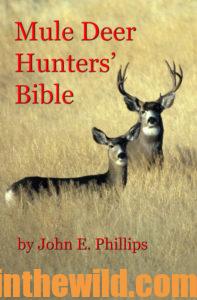
The reason I’m so high on using an angle-compensation range finder and practicing out to 70-80 yards is although I was shooting almost straight down on this most-difficult shot at a mule deer at 61 yards, I took the muley’s heart out. What was lucky about that shot was that when the arrow struck the mule deer, he started rolling downhill and ended up to within 10 yards of a county road. So, getting him out of the woods wasn’t difficult at all. And, no, that roll downhill didn’t damage that buck’s antlers at all.
To learn more about mule-deer hunting, check out John E. Phillips’ book, “Mule Deer Hunter’s Bible,” available in Kindle, print and soon to be available in Audible August, 2019, at https://amzn.to/2Kg62w5
Tomorrow: What Was Mark Drury’s Hardest Mule-Deer Hunt


